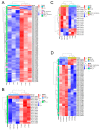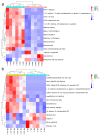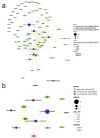Metabolome and Transcriptome Combinatory Profiling Reveals Fluconazole Resistance Mechanisms of Trichosporon asahii and the Role of Farnesol in Fluconazole Tolerance
- PMID: 38004810
- PMCID: PMC10672884
- DOI: 10.3390/microorganisms11112798
Metabolome and Transcriptome Combinatory Profiling Reveals Fluconazole Resistance Mechanisms of Trichosporon asahii and the Role of Farnesol in Fluconazole Tolerance
Abstract
Trichosporon asahii is a basidiomycete yeast that is pathogenic to humans and animals, and fluconazole-resistant strains have recently increased. Farnesol secreted by fungi is a factor that causes variations in fluconazole resistance; however, few studies have explored the underlying mechanisms. Therefore, this study aims to delineate the fluconazole resistance mechanisms of T. asahii and explore farnesol's effects on these processes. A comparative metabolome-transcriptome analysis of untreated fluconazole-sensitive (YAN), fluconazole-resistant (PB) T. asahii strains, and 25 μM farnesol-treated strains (YAN-25 and PB-25, respectively) was performed. The membrane lipid-related genes and metabolites were upregulated in the PB vs. YAN and PB-25 vs. PB comparisons. Farnesol demonstrated strain-dependent mechanisms underlying fluconazole tolerance between the YAN and PB strains, and upregulated and downregulated efflux pumps in PB-25 and YAN-25 strains, respectively. Membrane lipid-related metabolites were highly correlated with transporter-coding genes. Fluconazole resistance in T. asahii was induced by membrane lipid bio-synthesis activation. Farnesol inhibited fluconazole resistance in the sensitive strain, but enhanced resistance in the resistant strain by upregulating efflux pump genes and membrane lipids. This study offers valuable insights into the mechanisms underlying fungal drug resistance and provides guidance for future research aimed at developing more potent antifungal drugs for clinical use.
Keywords: Trichosporon asahii; farnesol; fluconazole resistance; metabolome; transcriptome.
Conflict of interest statement
The authors declare no conflict of interest.
Figures






Similar articles
-
Genomic and transcriptome identification of fluconazole-resistant genes for Trichosporon asahii.Med Mycol. 2020 Apr 1;58(3):393-400. doi: 10.1093/mmy/myz088. Med Mycol. 2020. PMID: 31504756
-
Implication of efflux pumps and ERG11 genes in resistance of clinical Trichosporon asahii isolates to fluconazole.J Med Microbiol. 2021 Mar;70(3). doi: 10.1099/jmm.0.001236. Epub 2021 Mar 10. J Med Microbiol. 2021. PMID: 33688802
-
Integrated transcriptomic analysis of Trichosporon Asahii uncovers the core genes and pathways of fluconazole resistance.Sci Rep. 2017 Dec 19;7(1):17847. doi: 10.1038/s41598-017-18072-9. Sci Rep. 2017. PMID: 29259317 Free PMC article.
-
Exploring the resistance mechanisms in Trichosporon asahii: Triazoles as the last defense for invasive trichosporonosis.Fungal Genet Biol. 2019 Dec;133:103267. doi: 10.1016/j.fgb.2019.103267. Epub 2019 Sep 9. Fungal Genet Biol. 2019. PMID: 31513917 Review.
-
[Antifungal susceptibility and drug-resistant mechanism of Trichosporon].Med Mycol J. 2015;56(4):J123-8. doi: 10.3314/mmj.56.J123. Med Mycol J. 2015. PMID: 26617108 Review. Japanese.
Cited by
-
Trichosporon asahii: emerging challenges in pathogenesis and drug resistance.Future Microbiol. 2025 Mar;20(4):333-343. doi: 10.1080/17460913.2025.2457858. Epub 2025 Jan 27. Future Microbiol. 2025. PMID: 39871602 Review.
-
Trichosporon and Antifungal Resistance: Current Knowledge and Gaps.Mycopathologia. 2025 Jul 4;190(4):59. doi: 10.1007/s11046-025-00969-z. Mycopathologia. 2025. PMID: 40613841 Review.
References
-
- Sugita T., Ichikawa T., Matsukura M., Sueda M., Takashima M., Ikeda R., Nishikawa A., Shinoda T. Genetic diversity and biochemical characteristics of Trichosporon asahii isolated from clinical specimens, houses of patients with summer-type-hypersensitivity pneumonitis, and environmental materials. J. Clin. Microbiol. 2001;39:2405–2411. doi: 10.1128/JCM.39.7.2405-2411.2001. - DOI - PMC - PubMed
-
- Wolf D.G., Falk R., Hacham M., Theelen B., Boekhout T., Scorzetti G., Shapiro M., Block C., Salkin I.F., Polacheck I. Multidrug-resistant Trichosporon asahii infection of nongranulocytopenic patients in three intensive care units. J. Clin. Microbiol. 2001;39:4420–4425. doi: 10.1128/JCM.39.12.4420-4425.2001. - DOI - PMC - PubMed
Grants and funding
LinkOut - more resources
Full Text Sources

